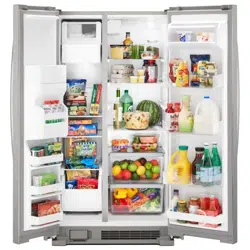Loading ...
Loading ...
Loading ...

34
NOTE:
■ This refrigerator is intended for use in a place where the
temperature ranges from a minimum of 55°F (13°C) to a
maximum of 110°F (43°C). For optimal performance, the best
room temperature range (to reduce the use of electricity and
to deliver superior cooling) is between 60°F (15°C) and 90°F
(32°C). You should not install the refrigerator near a heat
source, such as an oven or a radiator.
■ The minimum normal width required for the cabinet cutting
area to install the product is 36" (91.44 cm). However, if
you are installing the product against an extended wall and
you want to be able to remove the vegetable drawers, you
will need an extra 18" (45.72 cm) in the cabinet, hence we
recommend a total cabinet opening width of 54" (137.16 cm).
ELECTRICAL REQUIREMENTS
Electrical Shock Hazard
Plug into a grounded 3 prong outlet.
Do not remove ground prong.
Do not use an adapter.
Do not use an extension cord.
Failure to follow these instructions can result in death,
fire, or electrical shock.
WARNING
Before moving the refrigerator to its nal location, make sure that
you have the proper electrical connection.
Recommended grounding method
A 115 V, 60 Hz AC only, 15 or 20 A fused grounded electrical
supply is required. A separate dedicated circuit should be used
for the refrigerator. Use an outlet that cannot be turned off by a
switch. Do not use an extension cord.
NOTE: Before doing any type of installation or cleaning or
removing a light bulb, disconnect the refrigerator from the power
supply. When you have nished, reconnect the refrigerator to the
power supply and reset the control (of the thermostat, refrigerator
or freezer, depending on the model) to the desired setting. See
“Using the controls” in the User Instructions, User Manual or Use
and Care Guide.
WATER SUPPLY REQUIREMENTS
Gather the required tools and parts before starting the installation.
Read and follow the instructions provided with any of the tools
listed here.
TOOLS REQUIRED:
■ Flat-blade screwdriver ■ 1/4" nut driver
■ 1/4" drill bit
■ Cordless drill
■ 7/16" and 1/2" open-ended
wrenches or two adjustable
wrenches
NOTE: Your refrigerator dealer has a kit available with a
1/4"(6.35mm) saddle-type shutoff valve, a union and copper
tubing. Before purchasing, make sure that the saddle-type valve
complies with your local plumbing codes. Do not use a piercing-
type or 3/16" (4.76 mm) saddle valve which reduces water ow
and clogs more easily.
IMPORTANT:
■ All installations should be performed in accordance with local
plumbing requirements.
■ Use copper tubing and check for leaks. Install copper tubing
only in areas where the household temperatures will remain
above freezing point.
Water pressure
A cold water supply with a pressure between 30 and
120 psi (207 and 827 kPa) is required to operate the water
dispenser and ice maker. If you have any questions about water
pressure, call a licensed, qualied plumber.
■ If your refrigerator has a water dispenser: After completing the
installation, use the water dispenser to check the pressure.
■ Remove the water lter and dispense 1 cup (237 mL)
of water. If 1 cup (237 mL) of water is dispensed in 8
seconds or less, the refrigerator’s water pressure meets the
minimum requirements.
■ If it takes more than 8 seconds to dispense 1 cup (237 mL)
of water, this means that the refrigerator’s water pressure
is lower than recommended. See “Troubleshooting” for
suggestions.
Reverse osmosis water supply
IMPORTANT: The pressure of the water supply coming out of
a reverse osmosis system going to the water inlet valve of the
refrigerator needs to be between 30 and 120 psi (207 and
827 kPa).
f a reverse osmosis water ltration system is connected to your
cold water supply, the water pressure to the reverse osmosis
system needs to be a minimum of 40 to 60 psi (276 to 414 kPa).
If the water pressure to the reverse osmosis system is less than
40 to 60 psi (276 to 414 kPa):
■ Check to see whether the sediment lter in the reverse
osmosis system is blocked and replace the lter if necessary.
■ Allow the storage tank on the reverse osmosis system to rell
after heavy usage.
■ If your refrigerator has a water lter, the pressure can be
reduced even further if it is used together with a reverse
osmosis system. Remove the water lter. Consult “Water
ltration system” in the User Instructions, User Manual or Use
and Care Guide.
If you have any questions about water pressure, call an
authorized plumber.
CONNECT WATER SUPPLY
Read all the instructions before you begin.
IMPORTANT: If you turn the refrigerator on before the water
supply is connected, turn the ice maker off.
1/2" (12.7 mm)
2" (50.8 mm)
Loading ...
Loading ...
Loading ...
